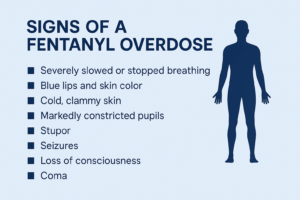How Long Does Fentanyl Stay in Your System?
Fentanyl is a powerful prescription opioid used to treat severe pain. Rates of fentanyl addiction have escalated in recent years, leading to an increase in overdoses and deaths. Some fentanyl is diverted from medical purposes for illicit use; however, much of the street supply of fentanyl is manufactured illegally.
Overdose is a serious concern with fentanyl, particularly since it is often combined with other substances. People who become addicted often require treatment with medications and/or therapy to help them quit using.
What Is Fentanyl?
Fentanyl is a synthetic opioid drug that is prescribed to treat severe pain, such as advanced cancer pain or chronic pain in patients who are tolerant to other, less potent opioids. 2 It is approximately 50 to 100 times stronger than morphine.1
Pharmaceutical fentanyl is available in several forms, including transdermal patch, lozenge, nasal spray, tablet, and injectable solution.3 Illicit fentanyl is usually found in powder form, as a tablet, spiked on blotter paper, or mixed with other drugs.2
People may swallow, snort, or inject illicit fentanyl. Some place the blotter paper in their mouth, where it is absorbed through the mucous membranes.2
Fentanyl overdoses are on the rise. More than 150 people die every day in the United States from overdoses involving synthetic opioids like fentanyl.1
The difference between a safe dose of the drug and one that can cause an overdose is quite small. Additionally, fentanyl is may be mixed with cocaine or heroin without the individual’s knowledge, making it even more dangerous.2
How Does Fentanyl Work?
Fentanyl attaches to and activates certain opioid receptors, which are located in areas of the brain that affect pain and emotion. Through its interaction with these receptors, fentanyl also increases the release of dopamine from certain nerve cells in our brain’s reward center.2 This resulting increase in dopamine activity is associated with a reinforcing sense of euphoria. However, the drug can also slow breathing, which, given fentanyl’s potency, greatly increases the risk of overdose.2
Some side effects of fentanyl use include:2,3
- Drowsiness.
- Confusion.
- Dizziness.
- Nausea.
- Vomiting.
- Constipation.
- Constricted pupils.
- Urinary retention.
- Respiratory depression.
Drug Tests and Fentanyl
Drug testing is conducted for many different reasons, including:4
- As a requirement for employment. Some employers require drug testing before hiring or periodically throughout employment to monitor drug use.
- In legal situations. Drug testing may also be ordered in the case of legal situations that need to be investigated like a crime or car accident.
- To assess dosing. Healthcare professionals may drug test to make sure a patient is taking the right dose of their medication.
How Long is Fentanyl in Your System?
While the effects of fentanyl may only be felt for a few hours, traces of the drug remain in the system for much longer—and everyone’s timeline is different, impacted by the dose taken, the duration of use, the frequency of use, an individual’s body weight, their urine concentration, their body chemistry, and any conditions they may have that affect the kidneys and liver.5
What Happens if You Take Too Much?
 Fentanyl’s potency makes overdose a real possibility, especially if the person uses it thinking it is another drug.2 Combining substances such as alcohol and benzodiazepines (Xanax, Klonopin, Valium) with fentanyl also increases the risk of overdose and death by respiratory arrest.6
Fentanyl’s potency makes overdose a real possibility, especially if the person uses it thinking it is another drug.2 Combining substances such as alcohol and benzodiazepines (Xanax, Klonopin, Valium) with fentanyl also increases the risk of overdose and death by respiratory arrest.6
Signs of fentanyl overdose include:3,7
- Severely slowed or stopped breathing.
- Blue lips and skin color.
- Cold, clammy skin.
- Markedly constricted pupils.
- Stupor.
- Seizures.
- Loss of consciousness.
- Coma.
An overdose can be fatal. Call 911 immediately if you suspect you or someone else may be experiencing an overdose. If it’s available, administer naloxone, an opioid receptor blocker that acts as an “antidote” to reverse the effects of opioids and restore breathing. Naloxone is available as a prefilled nasal spray or an injectable and is available for purchase without a prescription in pharmacies in all 50 states. Experts suggest that everyone keep naloxone on hand, but especially individuals who use fentanyl or other opioids or who have a loved one who does.7
How Can You Safely Stop Taking Fentanyl?
Individuals who have developed significant physical dependence on fentanyl are likely to experience withdrawal symptoms, which can be incredibly uncomfortable, when they try to go off the drug. The severity of withdrawal symptoms varies depending on the length and intensity of use.
Typical fentanyl withdrawal symptoms include:7
- Irritability.
- Feelings of depression.
- Loss of appetite.
- Trouble sleeping.
- Increased blood pressure.
- Increased heart rate.
- Nausea.
- Vomiting.
- Diarrhea.
- Runny nose.
- Watery eyes.
- Weakness.
- Chills.
- Muscle pain.
Fentanyl Addiction Treatment and Medications
Substance use treatment approaches have evolved to better help those impacted by the increasingly widespread opioid epidemic, which includes the misuse and addiction to prescription painkillers as well as drugs like heroin and illicit fentanyl and its analogs. Common treatment methods used to help people recover from opioid addiction include medications approved for opioid dependence and various behavioral therapies. Therapy and counseling combined with medication may increase the effectiveness of treatment.8
- Buprenorphine (which can be administered alone or in combination with naloxone, as Suboxone) and methadone are opioid receptor agonist drugs, meaning that, to differing extents, they activate the same receptor system that fentanyl acts on to reduce the intensity of cravings and withdrawal symptoms. Naltrexone, which is sometimes used post-detox, is what’s known as an opioid antagonist—it also binds to opioid receptors but, in doing so, prevents fentanyl from producing effects.8
- Behavioral therapies help people adjust thinking patterns and behaviors around fentanyl use, develop better coping skills, and more adaptively react to any triggers that are encountered. Cognitive-behavioral therapy (CBT) is perhaps the most well-known of these therapies.8
Finding Help for Substance Abuse
If you’re concerned about the dangers of fentanyl or struggling with any type of opioid addiction, get help today. A variety of programs are available across the country that offer various levels of care, therapies, and services to ensure that you get treatment that’s tailored to your unique needs. If you experience symptoms of withdrawal, you will likely begin treatment with a medically supervised detox program before moving into a more comprehensive treatment program that may take place in an inpatient or residential setting or an outpatient program.
Asking for help is an important first step, and American Addiction Centers (AAC) is here to guide you through your recovery journey. Apply for rehab online or call us today to speak to one of our compassionate and knowledgeable admissions navigators, who can listen to your story, answer your questions, and help you start treatment today.
